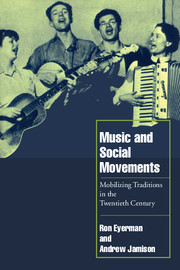Book contents
- Frontmatter
- Contents
- Acknowledgments
- Introduction
- 1 On social movements and culture
- 2 Taking traditions seriously
- 3 Making an alternative popular culture: from populism to the popular front
- 4 The movements of black music: from the New Negro to civil rights
- 5 Politics and music in the 1960s
- 6 From the sixties to the nineties: the case of Sweden
- 7 Structures of feeling and cognitive praxis
- Notes
- Bibliography
- Index
Introduction
Published online by Cambridge University Press: 26 October 2011
- Frontmatter
- Contents
- Acknowledgments
- Introduction
- 1 On social movements and culture
- 2 Taking traditions seriously
- 3 Making an alternative popular culture: from populism to the popular front
- 4 The movements of black music: from the New Negro to civil rights
- 5 Politics and music in the 1960s
- 6 From the sixties to the nineties: the case of Sweden
- 7 Structures of feeling and cognitive praxis
- Notes
- Bibliography
- Index
Summary
In April 1995, we attended a memorial celebration for Ralph Rinzler, a central musical activist in the 1960s social movements, at the Highlander Center, outside Knoxville, Tennessee, where Pete Seeger and Bernice Johnson Reagon and many others who had known Rinzler sang their songs of union organizing and civil rights struggle. Appropriately enough, it was there that the ideas in this book suddenly began to take form. Seeing and listening to Seeger and Reagon, along with “Doc” Watson, Mike and Peggy Seeger, Eric Weissberg, Jim Rooney, Hazel Dickens, and so many others, at the Highlander Center helped us to formulate the central arguments in this book. We saw, and felt, how songs could conjure up long-lost social movements, and how music could provide an important vehicle for the diffusion of movement ideas into the broader culture.
It was at Highlander, which, since the 1930s, has contributed so much to so many political movements, that the main point of this book became clear, namely that social movements are not merely political activities. Perhaps even more importantly, they provide spaces for cultural growth and experimentation, for the mixing of musical and other artistic genres, and for the infusion of new kinds of meaning into music. At Highlander, we saw some of the “results” of the movements of the 1960s, and the enormous influence that the mixing of music and politics had come to have on the popular culture.
- Type
- Chapter
- Information
- Music and Social MovementsMobilizing Traditions in the Twentieth Century, pp. 1 - 5Publisher: Cambridge University PressPrint publication year: 1998

